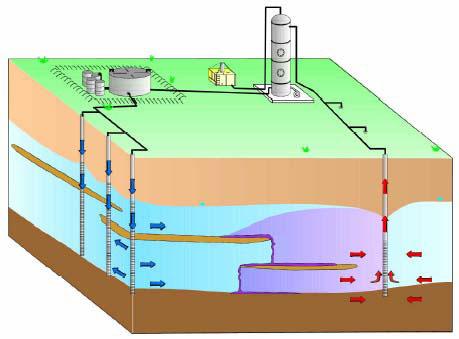You are here
Mass-flux Reduction and Mass Removal Relationships (MFR-MR) of Pool-dominated Multicomponent DNAPLs in Heterogeneous Geological System

Contamination of groundwater by chlorinated solvents such as trichloroethylene (TCE, tetrachloroethylene (PCE), and 1,1-dichloroethylene (1,1DCE) is a widespread problem that can seriously threaten human health and the environment. These compounds are often present as dense nonaqueous phase liquid (DNAPL) mixtures in the subsurface that serve as a long-term groundwater contamination sources. The objective of this study is to test the effectiveness of different in-situ flushing agents (SDS, Tween 80, MCD, and water) for the recovery of DNAPL mixtures (TCE, PCE, 1,1DCE) entrapped in heterogeneous aquifer media. A series of batch tests were first performed to assess the multiphase behavior of water-DNAPL mixture-reagent system. Intermediate scale tank experiments were then performed to compare the performance of the reagent solutions. The flushing breakthrough curves were also used to investigate the impact of solubilization agents on mass-flux reduction/mass-removal behavior relationships. Performance of agents on DNAPL mixture source zone remediation was found to be in the following order: Tween 80>SDS>MCD>>Water. Individual DNAPL constituents exhibited transient effective solubilities that depend on the reagent contents and DNAPL compositions. Although high fractions of DNAPL source zones in heterogeneous porous media were removed through chemical flushing (SDS, Tween 80, MCD, and water), the heterogeneous system exhibited an extended multi-step concentration behavior. The results emphasized that in the early stage, some portion of the organic liquid is hydraulically accessible (matrix) whereas the later stage of mass removal was controlled by the more poorly accessible mass (pool) associated with higher-saturation zones. Our results also showed that the distribution and the emplacement of organic liquid, flow-field heterogeneity, sorption and desorption, and flushing solution all influenced the DNAPL mixture removal. The results from this study underline the need for understanding the multiphase behaviour of a system, particularly when DNAPL mixtures are present, prior to field-scale remediation implementation.
